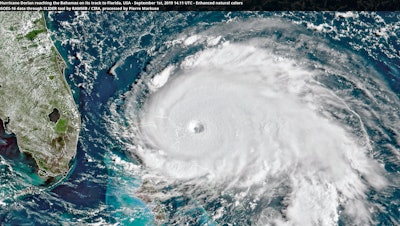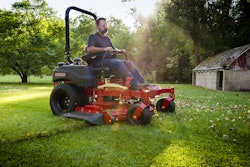 Hurricane Dorian reaching the Bahamas on its track to Florida on Sept. 1, 2019.
Hurricane Dorian reaching the Bahamas on its track to Florida on Sept. 1, 2019.Photo: Pierre Markuse/Flickr
With the havoc Hurricane Dorian brought upon the Bahamas over the past few days, members of Florida, Georgia and the Carolinas have begun battening down the hatches for what may come.
If your landscaping company is located near or in Dorian’s path, now would be a good time to prepare your customer’s landscapes and your company for what might be on the horizon.
Having a hurricane preparedness plan in place for your company could help save lives, as well as help preserve your customer’s landscape, so take a look at a few things to keep in mind when preparing for an impending storm.
Update on Dorian
According to a tweet from the National Hurricane Center (NHC), Dorian had maximum sustained winds of 105 mph as of 5 a.m. EDT this morning. CBS News reports that Dorian’s core was around 90 miles east of Dayton Beach, Florida, and it was moving north-west at 8 mph. CBS News also says that hurricane-force winds extended outward up to 60 miles from the center of the hurricane, and tropical storm-force winds extended outward up to 175 miles.
“While Dorian has stayed far enough off the coast to largely spare Florida from the worst of its wrath, it is forecast to make a much closer approach to the coastline of the Carolinas between late Wednesday and Thursday and could even make landfall,” The Washington Post said online.
According to CNN, 21 counties in Georgia are now under a state of emergency, and seven counties in Florida are still under mandatory evacuation: Clay, Duval, Flagler, Nassau, Putnam, St. John’s and Volusia.
“Impacts are thus expected to be more severe,” The Washington Post said online.“Around Charleston, South Carolina, for example, wind gusts could hit 80 mph, and water levels could rank among the top five levels ever recorded due to the combination of ocean surge and up to 15 inches of rain.”
Hurricane prep
According to the National Hurricane Survival Initiative, 40 percent of small businesses that close due to hurricane damage do not reopen.
Overall, there are three main steps you need to take to help prepare and protect your landscaping company from a hurricane: maintain an emergency kit, protect your property and protect important documents and information.
When looking at your company’s physical building, consider installing hurricane shutters or covering windows with plywood. The roof should also be evaluated to find out if it can withstand the impending storm, and any nearby branches should be removed to keep them from falling on and damaging the structure.
If possible, it’s a good idea to make sure utilities are turned off before the hurricane gets to your area. Within the building, be sure to anchor and brace large furniture, such as filing cabinets and shelves, and put sandbags down in any area that could be subject to flooding.
When gathering important information, always bring any documents that would be hard to produce, such as insurance documents, legal contracts, tax returns and accounting statements. Make sure these items are stored securely in a waterproof container and make sure you have backup copies made.
Along with your paper information, be sure to have backups of your technological information and data. This can be backed up and stored at an off-site location so it can be recovered if the physical computer or device is damaged during the hurricane.
Whether the storm hits unexpectedly or you’ve seen it coming for awhile, it’s always a good plan to have an emergency preparedness kit on hand that you and your staff know about and are familiar with.
Before the hurricane reaches your location, be sure you have an updated contact list for all of your employees, as well as alternative numbers in case their primary one is nonoperational. Also, take time to reach out to your customers ahead of time and notify them that the business will be closed.
Once the storm has concluded, check in with your employees using the contact sheet, and evaluate any possible damage done to your establishment, which will include downed power lines or broken water lines. Document and take photos of any damage before you start fixing it, and contact your customers as soon as you can to let them know the company’s current situation.
Trees will be very vulnerable to strong winds, which could uproot younger trees or cause damage to your customer’s property. Check the landscape to ensure that younger trees are staked properly and make sure these stakes are secured deeply into the ground with a strong rope.
Be sure to trim back any weak or dead branches from larger trees to keep them from flying away in the wind and to prevent damage to the windows or siding of your customer’s home.
For trees and plants that are close to your customer’s home, be sure to prune them away from the house and remove the debris out of the yard. If there are any dead trees, shrubs or plants, go ahead and remove them as well to cut down on any potential flying debris.











